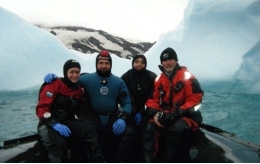02-05-2016
Antarctic bryozoans give hints of environmental changes in oceans
Antarctic regions are natural laboratories to study biodiversity and the impact of climate change. In Antarctica some marine ecosystems are particularly vulnerable to the ocean acidification due to an excess of CO2 released into the atmosphere. Studying the Antarctic bryozoans, marine invertebrates that live in colonies and make mineralized skeletons, can create new views to understand the effects of global ocean acidification, according to an article published in the journal Marine Ecology Progress Series and signed by Blanca Figuerola, researcher at the Department of Evolutionary Biology, Ecology and Environmental Sciences and Biodiversity Research Institute of the UB (IRBio), Piotr Kuklinski (Institute of Oceanology) and Paul D. Taylor (Natural History Museum, UK).
Further information
Article reference:
Figuerola, B.; Kuklinski, P.; Taylor, P.D. «Depth patterns in Antarctic bryozoan skeletal Mg-calcite: Can they provide an analogue for future environmental changes?», Marine Ecology Progress Series, November 2015. Doi: 10.3354/meps11515
Further information
Article reference:
Figuerola, B.; Kuklinski, P.; Taylor, P.D. «Depth patterns in Antarctic bryozoan skeletal Mg-calcite: Can they provide an analogue for future environmental changes?», Marine Ecology Progress Series, November 2015. Doi: 10.3354/meps11515
